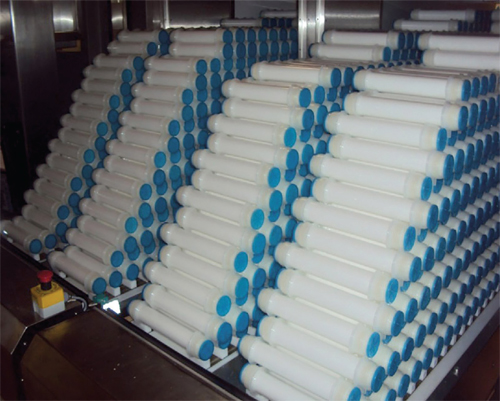
The main challenge in automating a dialyzer handling unit was that the dialyzers are stacked unevenly and their positions vary along three dimensions. An automation system needed to recognize the individual dialyzer positions.
Fresenius Medical Care SMAD uses a smart system to handle uneven stacks of dialyzers. This system consists of a robot that uses two 2D sensors to detect the position of dialyzers and move them to a conveyor without human intervention 24 hours a day, 7 days a week.
Fresenius Medical Care SMAD specializes in kidney disease treatment, offering a comprehensive range of services and products for patients with chronic kidney failure. Operations are primarily focused on the production of two main types of product: dialysis filters (aka dialyzers) and bags of dry or liquid concentrates. Concentrates are salts that are used to prepare dialysis fluid, which is similar in composition to blood plasma.
The dialyzer production line at its plant in east-central France is equipped with the robot. “In 2009 we decided to automate our dialyzer handling unit, which is located between a conveyor system and a processing unit. Automating the unit was an obvious solution. The main challenge was that the dialyzers are stacked unevenly and their positions vary along three dimensions. We had to find a system that could recognize their positions,” said Mouloud Ifri of Fresenius Medical Care SMAD’s Manufacturing Dept.
Automating the line was necessary for two reasons: it is installed in a controlled environment—problematic for human intervention—and it operated at high speed 24/7.
The feed system consists of two conveyors, each with two rows of dialyzers. The robot is equipped with a tool that allows it to pick up two dialyzers per cycle. The tool is fitted with two Keyence LJ-G080 laser sensors, one per dialyzer, so that the dialyzers are correctly picked up one after the other.
The robot thus simultaneously removes dialyzers from each stack on a conveyor. It takes dialyzers from the two conveyors in turn. When a row (diagonal) is emptied, the conveyor moves forward until the stack reaches the unloading position.
The robot routinely “scans” the theoretical positions depending on the type of product. It uses the Keyence sensors to detect products and correct its pickup position accordingly. If no products are detected, the robot moves to a different stack. It also uses the sensors to correct its X- and Z-axes. To compensate for dispersion along the robot’s Y-axis, the robot’s tool is fitted with a homing cylinder for each type of dialyzer.
The maximum height and slope of the stacks are always the same for the same type of product. However, these stacks may be uneven.
“We first considered installing an industrial vision system. However, the cost and complexity involved led us to scrap that idea. We then looked at a 2D laser measurement sensor provided by a competitor, but found it to be complicated to implement.”
Ultimately, the installation team chose the LJ-G080 sensor by Keyence. Its user-friendly settings menu means that experienced and novice users can configure settings easily and quickly. The setting support software (LJ-H1W) supplied with the device makes it easy to save and analyze data with a PC.
Configuration is also made easy by several adjustment functions. For example, position adjustment ensures accurate measurements even when targets are not perfectly arranged or positioned. The tilt correction function simplifies installation of the sensor head and eliminates measurement errors.
 A number of functions make measurements to the surface properties of targets (shiny, dull, for example). “We also place high demands on the robustness and reliability of equipment,” said Ifri.
A number of functions make measurements to the surface properties of targets (shiny, dull, for example). “We also place high demands on the robustness and reliability of equipment,” said Ifri.
The LJ-G sensor delivers reliable detection over time, offering repeatability of 1 µ along the Z-axis and 10 µ along the X-axis. It is protected inside an IP67 housing and withstands vibrations tested from 10 to 55 Hz, with an amplitude of 1.5 mm, for two hours along X, Y and Z. It weighs 350 g and has a detection range of 80 mm.
Keyence
www.keyence.com
Filed Under: Aerospace + defense, The Robot Report, Medical-device manufacture, MOTION CONTROL, SENSORS, MORE INDUSTRIES





Tell Us What You Think!